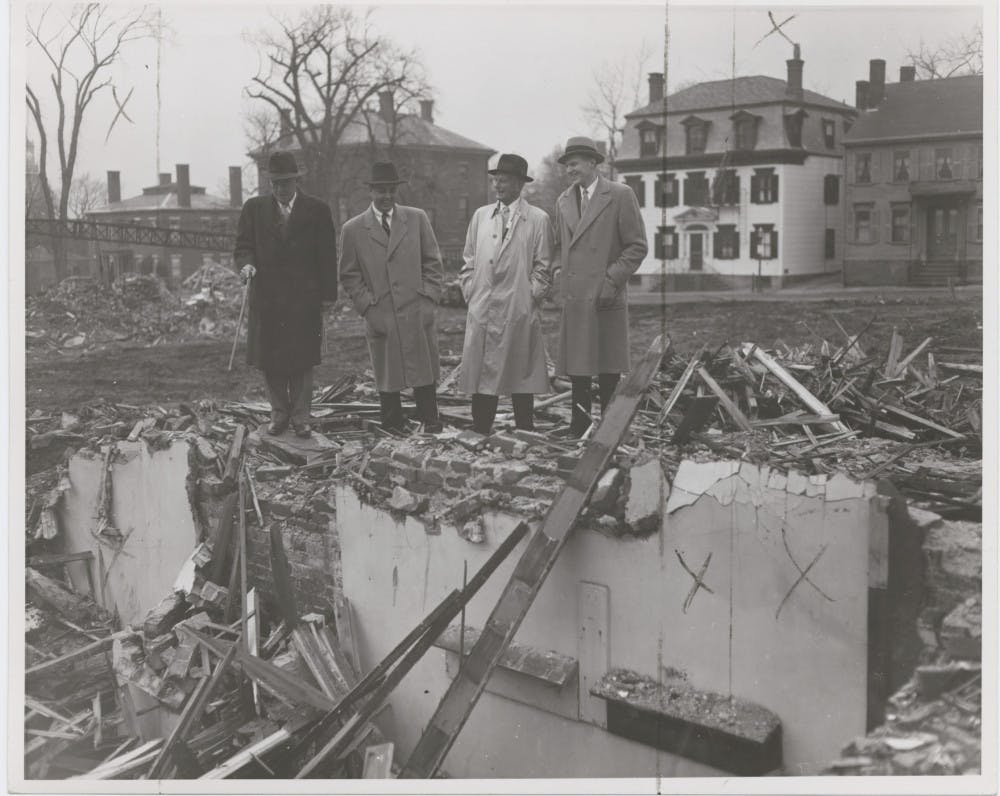Bracketed by the Van Wickle Gates and Soldiers Arch, Brown's bustling campus 50 years ago reached little beyond the Main Green and Lincoln Field. A residential neighborhood of old colonial homes and stately Victorian mansions extended right to its doorstep.
Today, the University sprawls over most of College Hill, and has plans to expand even further into the city. But this growth has brought controversy as the University's boundaries have blurred.
It was a shift that Ed Bishop '54 P'86 P'91, a long-time Providence resident, witnessed as a student: the University's struggle to grow in an urban neighborhood without, at the time, any "perspective on preservation."
Wriston Quadrangle was being built when he was a first-year student, and construction on Keeney Quadrangle had not yet begun. Those projects, each landmark expansions that left an indelible mark on the face of College Hill, set Brown on the path to becoming a major research institution that could accommodate a larger student body.
Bishop said he remembers being part of a student body that was largely indifferent to the historic property lost during the construction of the Sharpe Refectory and new residence halls. But Wriston, where 51 historic homes once stood, was the first major battlefield in the University's conflict with neighboring communities as it started to expand.
At such times, there has been a feeling among College Hill residents, Bishop said, that "Brown is a 1,000-pound gorilla and is going to get what it wants in the long run."
But since its early clashes with East Side residents, Bishop said, the University has altered its attitude toward College Hill's preservation and become more willing to compromise with its neighbors.
Brown has come a long way since its "scorched-earth policy," said Peter Mackie '59, an archivist at the John Hay Library, of the University's approach of large-scale demolition in the 1950s. "I think the light has finally dawned on College Hill that we're part of the fabric of this community," he said.
Wriston's wrecking ball
The University began buying up parcels of land near its existing property in 1922, commencing a decades-long project that added on-campus housing for nearly 1,500 students. The University expected a post-war boom in enrollment that would increase the size of the student body to 2,000, and at the time, Brown's residence halls lacked the capacity to serve so many students.
But then-President Henry Wriston had additional reasons for beginning Brown's first major expansion project — the "New Quadrangle" that later came to bear his name.
The behavior and less-than-ideal academic performance in Brown's fraternities spurred University administrators to buy up the frats' off-campus houses and move the students into University housing, according to Bishop. Creating residence halls that consolidated the school's frats in a single on-campus location gave administrators more control over their activities.
Creating the quadrangle required wrangling with the city of Providence, including obtaining the city's approval to remove the section of Benevolent Street that lay between Brown and Thayer streets, running straight through the planned quad.
The greatest outcry, though, was raised over the fate of the 51 historic homes that had stood for more than 100 years on the property, including eight colonial houses built before 1830 and several Victorian mansions.
In an attempt at preservation, Brown moved two early houses to Benevolent Street and offered the rest up for sale and relocation. But only eight of the colonial homes were bought and moved, and in early 1949 Brown's wrecking balls initiated the "first phase of one of the largest land clearing projects in the city's history," as the Providence Journal recorded on the first day of demolition.
"It was not so much the value of the individual buildings," said Victoria Veh, interim executive director of the Providence Preservation Society. "It was the context of an entire neighborhood being eliminated."
The preservation society formed partly as a response to the loss of historic buildings originally on Wriston.
Construction continued determinedly over the next three years. Upon its completion in 1952, the $6.5 million quad represented about a third of Brown's physical campus — but marked only the beginning of President Wriston's grand scheme for Brown's transformation from a local New England college to a nationally competitive university.
Housing a growing institution
Wriston's successor, President Barnaby Keeney, continued expansion, provoking organized opposition from neighbors who remembered the demolition that laid the groundwork for Wriston Quad's construction.
The University offered up for sale eight houses that would otherwise be destroyed to make way for Keeney Quad. Though each house was being sold for $1, it would have cost the purchasers $30,000 to $40,000 to move each building to a new location.
No buyers came forward for 125 Charlesfield St. or 17 Benevolent St. — both of which were built around 1823. In December 1955, East Side residents mobilized to try to forestall the historic homes' impending demolition, amassing 106 signatures for a petition that asked the University to incorporate the two buildings into the new quad's design.
Such a move, the petition stated, would "rejoice the hearts of many citizens saddened by the obliteration of so many homes which have for generations given this part of Providence a distinctive character."
The University rejected the residents' proposal. To meet the deadline for the quad's completion — February 1, 1957 — the demolition had to begin, President Keeney said. The cranes rolled onto Brown Street, razing the houses, the Monday after the petition was presented.
"When one is destroyed," Antoinette Downing, an historian of local architecture and Brown faculty spouse, told the Journal in 1955, "it is like destroying the last copy of an irreplaceable book."
Downing maintained that the preservation of College Hill's historic architecture did not impede the University's need to expand — that, if anything, preservation was the responsibility of an institution such as Brown.
"Preserving buildings doesn't mean going back to live in the past but simply to enrich present-day life," Downing told the Journal. "It's the sort of thing a university stands for when it stands for liberal education."
Brown's ‘conscience of history'
Having lost their fight, East Side residents were determined that similar destruction never happen again. In 1956, Downing helped found the Providence Preservation Society, which has since been a major force in maintaining College Hill's architectural heritage and transforming Providence into a city known for its historic feel.
"We like to say that Brown was responsible for the founding of the society," said Robert Emlen, the University curator and senior lecturer in American Civilization, who was a member of the society's board of directors from 1989 to 1995. "Brown was knocking down everything in sight," he said.
One of the society's first undertakings, though, did not directly concern Brown. Instead, in the 50s and 60s the preservation society faced off against the federal government, which proposed knocking down buildings on Benefit Street to build public housing projects.
At the time, the street looked nothing like it does today.
"Benefit Street was like a Halloween movie set." Mackie recalled. "The houses were dilapidated, run-down."
Mostly low-income families inhabited the "slum" that was Benefit Street, with many families living in single rooms, Mackie said.
The street was a place of poverty and prostitution, said Dietrich Neumann, professor of history of art and architecture.
The preservation society encouraged local residents to buy property in the run-down area and resto
re it, saving it from destruction at the hands of the government, he said. But in the process, the street's real-estate value skyrocketed, making it too expensive for the families who lived on it.
While the street's gentrification made it "economically more viable," Neumann said, it also lost many of its former functions — once dotted with garages, businesses and a library, the street is now a "purely residential" neighborhood.
Despite its origins, the preservation society and Brown have developed a more collaborative and cooperative relationship. The society has become "almost the conscience of history" for Brown, Mackie said, helping make the University and local residents "much more sensitive" to the historic value of their shared neighborhood.
Balancing competing priorities today
Mackie and Emlen both said Brown has recently become more mindful of its neighbors' needs during expansion.
The neighborhood surrounding Brown's campus is an asset to the University, Emlen said. "You can walk across the street and be in a beautiful neighborhood," he added.
But as the University expands, it still struggles to balance its students' needs with local residents' priorities.
"Sometimes the needs of the people in the neighborhood are diametrically opposed to what the institution needs," Emlen said, citing handicap accessibility and modern security measures as much-needed features older buildings may not have.
Mackie and Emlen both said that the sciences in particular demand up-to-date facilities.
"It's not that Brown is wrong," Emlen said. "If you want to teach biochem, you can't do it in a little beat-up house." For example, he said, laboratory spaces need modern climate control.
As Brown enters its latest phase of growth, it may have found a compromise that gives it the modern facilities it requires to leapfrog its immediate neighbors and expand into new areas off campus. Last weekend, the Corporation gave the green light for renovations to begin early next year on a new Medical Education Building at 222 Richmond St. in the Jewelry District downtown.
Two major factors influenced Brown's decision to expand elsewhere, said Frances Halsband, the architect hired in 2003 to plan the campus's growth. Because of an "institutional zone" that regulates how and where the University can build on its property, "there wasn't the possibility that Brown could expand any more on College Hill," she said.
Residents' concern for their historic district also influenced Brown's choice to move the Alpert Medical School off the Hill, Halsband said.
"I guess that we and the trustees ultimately realized that the neighbors were right — Brown is in a very fragile and beautiful setting," she said, adding that the priorities of the neighborhood surrounding Brown are an important consideration in campus planning.
"I think that you've got to see any entity as part of a larger community and part of a larger environment," she said.
No matter what, the University still has to grow.
"It doesn't want to be an institution of the 1990s or the 1970s," Emlen said. "It has got to keep up."

ADVERTISEMENT




